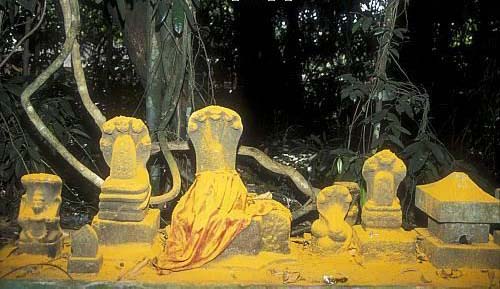|
|
Mannarasala Sree Nagaraja Temple

Name of the Temple |
- Mannārasāla Śhrī Nāgarāja Temple
|
Location |
- The temple is located about three kilometers to the south-east of the bus station in N.H.47 at Haripāḍu, in Alleppey district of Keraḷa.
|
| How to reach there? |
- By Air : The nearest airports are Kochi International Airport, 115 km north of Mannārśhāla and Thiruvananthapuram International Airport, 125 km south of Mannārśhāla.
- By Train : The nearest railway stations are Haripāḍ (3 km), Māvelikkara (10 km) and Kāyamkuḷam (11 km).
- By Road: TheNational Highway 66 from Kanyākumari to Panvel connects Mannārśhāla with the rest of the state.
|
Rulers/builders and Time Period |
- Though the legends related to the origin of a place cannot be deemed as its history, the story on the evolution of Mannārasāla as the supreme place of worship of the serpent Gods is associated with Paraśhurāma, the creator of Keraḷa.
- Paraśhurāma, the son of Bhrigu, was also known as Bhārghavarāma decided to seek release from the sin of killing the Kṣhathriyas. He approached the holy Riṣhis. They suggested that he should make a gift of a land of his own to the Brahmins.
- Paraśhurāma propitiated Varuṇa Dheva (the Lord of the Seas) to get some land for himself. He threw into the sea the axe which Parama Śhiva had given him with his blessings. Thus he raised the land from the sea and gave it as a gift to the Brahmins according to the rules. This land came to be known as Keraḷa.
- That piece of land was not habitable because of the salinity. Not even vegetables grew there. People began to leave the place. Bhārghavarāma was pained at this. He undertook penance to please Lord Śhiva, who advised him that the objective could be realized only if the flaming poison of the serpents was spread everywhere and that the only means of doing that was the worship of Nāgarāja.
- Paraśhurāma, a Yogi, firm of will and above all desires, decided that he would take no rest until he saw Keraḷa come up as a land of evergreen beauty full of trees and plants, prosperous in every way. He set out with his disciples in search of a deserted jungle in order to please Nāgarāja who was inaccessible and beyond anybody understands.
- He found a suitable place near the seashore in the southern part of Keraḷa. Satisfied with having found a proper place for the realization of his cherished dream, the great Riṣhi constructed a Thīrthasthhala for the performance of penance. Paraśhurāma, a partial incarnation of Lord Vishnu, had to undertake very severe penance.
- Nāgarāja, who was pleased, appeared before Paraśhurāma willing to grant him his desire. Paraśhurāma prostrated at the lotus feet of Nāgarāja and prayed to realize his objective. Nāgarāja granted his request with great pleasure.
- Ferocious serpents arrived at the spot at once to spread the flaming Kālakūṭa poison. Because of the percolation of poison, the land of Keraḷa was desalinated, to become habitable with envious greenery. Paraśhurāma then requested the Lord to bless the land forever with his eternal presence, and that was also accepted by the kindly-disposed Nāgarāja.
|
Deity/Deities |
|
Architecture Style |
- The entrance to the temple, surrounded by about 16 acres of thick green forest, is lined with rows of stone images of serpents reportedly 30,000 of them.
|
Special Reference to Fine Arts |
- On the eastern side of the temple 'Pulluvans' (a community) sing 'Pulluvan Pāṭṭu' (serpent songs) with ardent faith.
|
Other Special Features |
- Paraśhurāma, who installed the deities at the Mannārasāla temple, also had given inviolable instructions to be followed to preserve the sanctity of the place, as well as to take care of the Naga deities in the blessed land made by him.
- He instructed that every individual born in Kerala, without discrimination, should worship serpent gods every day and set apart, as a serpent grove, one-fourth of his compound in the south-east or south-west corner.
- They should offer worship to the serpents who live in the serpent's pits, chithrakūṭas etc., and who are visible deities, with fear, devotion and faith. The worship of serpents should be carried out with great respect for the good of their ancestors, as well as their family deities and for the prosperity of their own family.
- It is believed that even today in Kerala that the five-hooded Nāgarāja stays in the cellar doing Thapas for the abound prosperity of his dependents. The members of the household always refer to him with great respect and devotion as Mutthaśśhan and Appūppan (Grandfather). The jungle close by is the exclusive preserve for his unobstructed peregrinations (Appūppan Kāvu - Grandfathers' Grove).
|
Special Reference to Performing Arts: |
- The history of Mannārasāla has been mentioned in the 'Mandhara Salodhayam' Sanskrit poem written by Mannārasāla M.G.Nārāyaṇan Nambūdhiri of the sacred family, who wrote it on the basis of reliable accounts and legends traditionally handed down and in the light of old books available with the temple.
- Since the poem was incomplete, the history narrated here is from the book 'The Serpent Temple Mannārasāla ', published by Mr.N.Jayadhevan of Mānasa Publications (Translated to English by the renowned scholar Dr.Ayyappa Panikker). This book is also based on the advice and instructions received from the former Great Mother, and in accordance with the other members of the family as well as the old records examined for the purpose.
|
Bibliography |
|
|
View Larger Map 



|
|















